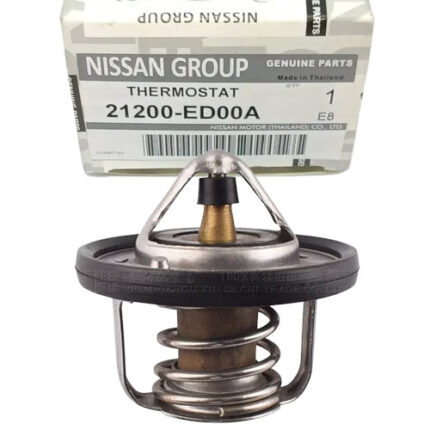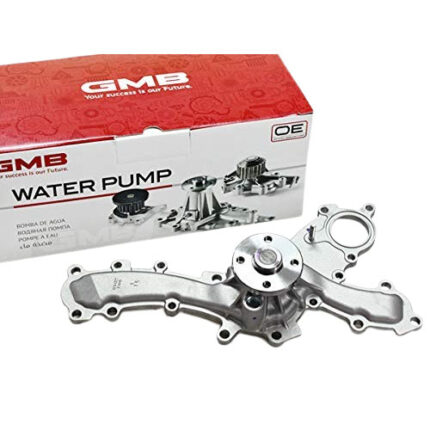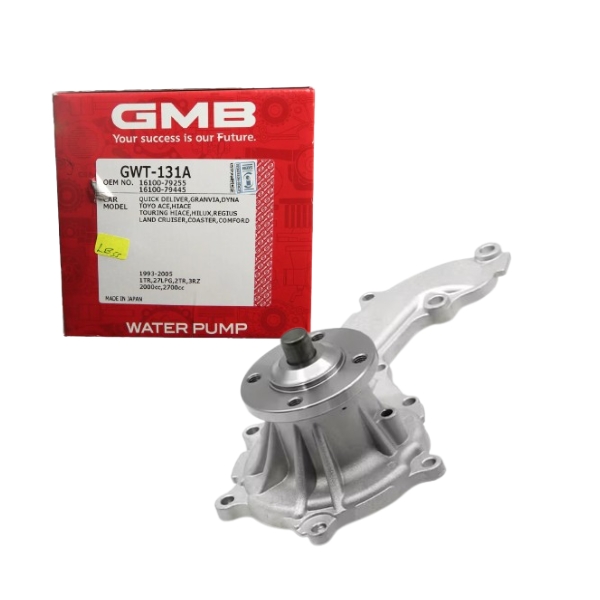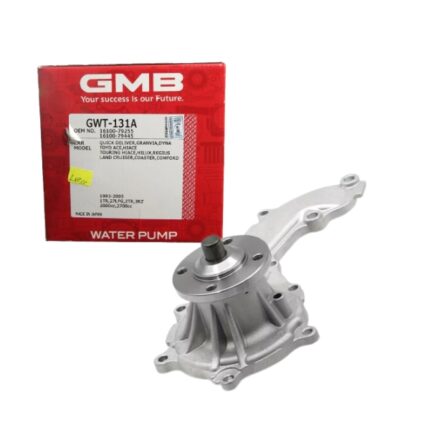Get Engine Water Pump Assy For Toyota Prado 2TR Engine GWT-131 in Kenya
The Engine Water Pump Assembly GWT-131 is a critical component in the engine’s cooling system, specifically engineered to circulate coolant through the engine block, radiator, and associated hoses to maintain optimal operating temperature. Without a properly functioning water pump, an engine can overheat, suffer from thermal stress, and sustain significant internal damage.
The GWT-131 water pump is precision-manufactured to meet or exceed OEM standards, offering reliable coolant flow, long-term durability, and efficient heat management across a wide range of driving conditions. It plays a central role in thermal regulation, ensuring consistent engine performance and longevity.
Construction and Design Features
The GWT-131 water pump is designed with exact tolerances and rugged materials to deliver high performance under demanding engine conditions. Its construction includes:
-
Pump Housing – Usually made from cast aluminum or cast iron for strength, heat resistance, and corrosion protection.
-
Impeller – The core pumping mechanism, which may be made from metal, high-strength plastic, or composite materials. It rotates to generate centrifugal force that drives coolant circulation.
-
Shaft and Bearings – A robust shaft assembly supported by high-precision bearings, ensuring smooth operation with minimal friction.
-
Seal Assembly – Includes mechanical seals that prevent coolant leakage from the shaft area while withstanding both pressure and temperature extremes.
-
Mounting Flange and Bolt Holes – Designed for a direct-fit installation, aligning perfectly with the engine block and accessory drive system.
-
Pulley (if applicable) – In belt-driven designs, a pulley is either integrated or mounted to the shaft to accept the drive belt from the crankshaft.
Each GWT-131 pump is pressure-tested and balanced to ensure vibration-free performance, extended bearing life, and quiet operation.
Function and Role in Engine Cooling
The GWT-131 water pump serves as the heart of the engine’s cooling system. Its primary role is to circulate coolant—typically a mixture of water and antifreeze—throughout the engine and cooling circuit. Here’s how it works:
-
Coolant Intake – Coolant from the radiator enters the pump through an inlet passage.
-
Impeller Rotation – Driven by the engine (via timing belt, serpentine belt, or gear), the impeller spins to generate centrifugal force.
-
Coolant Circulation – This force pushes coolant outward through engine passages, absorbing heat from combustion areas and transporting it to the radiator.
-
Heat Dissipation – In the radiator, coolant releases heat into the air via radiator fins before returning to the pump for another cycle.
Without the constant flow provided by the water pump, localized overheating could occur inside the engine block or cylinder head, leading to warping, gasket failure, or seizure.
Advantages of the GWT-131 Water Pump Assembly
Choosing the GWT-131 water pump offers a range of benefits related to engine performance, longevity, and efficiency:
-
Reliable Coolant Flow – Maintains optimal engine temperature, preventing overheating or thermal cycling damage.
-
Precision Engineering – Built to OEM specifications for perfect fitment and performance.
-
Quiet Operation – Balanced impeller and high-quality bearings minimize noise and vibration.
-
Corrosion Resistance – Coatings and seal designs reduce the risk of rust, electrolysis, and erosion from coolant flow.
-
Enhanced Seal Integrity – Reduces the risk of leaks, a common failure point in older or inferior pumps.
-
Extended Lifespan – Engineered to perform over long service intervals under various temperature and pressure conditions.
These attributes make the GWT-131 ideal for preventive maintenance or direct replacement in both routine service and repair situations.
Symptoms of a Failing Water Pump
Recognizing the signs of a failing water pump is essential to avoid costly engine damage. Common symptoms associated with a worn or malfunctioning GWT-131 water pump include:
-
Coolant Leaks – Visible coolant dripping or pooling under the engine bay, especially near the timing cover or accessory belt.
-
Overheating Engine – Elevated engine temperatures or frequent overheating, indicating insufficient coolant circulation.
-
Grinding or Whining Noise – Worn bearings can produce high-pitched or rumbling sounds, particularly noticeable at idle or under load.
-
Coolant Contamination – Rust particles or debris in the coolant reservoir may suggest internal corrosion or impeller damage.
-
Steam or Pressure Buildup – Steam from under the hood or high-pressure coolant hoses could signal coolant not reaching the radiator.
-
Visible Shaft Wobble or Pulley Play – Excessive shaft movement indicates bearing failure, compromising pump alignment and belt integrity.
Early detection and replacement can prevent engine overheating, head gasket failure, and permanent engine damage.
Installation Procedure and Best Practices
The installation of the GWT-131 water pump should be performed carefully and with proper tools. While the process can vary depending on engine layout and design, typical steps include:
-
Drain Coolant System – Remove existing coolant from the radiator and engine block to prevent spills.
-
Remove Belts and Components – Detach the serpentine or timing belt, fan, and other accessories that obstruct pump access.
-
Unbolt the Old Water Pump – Carefully remove mounting bolts and detach the old pump from the engine surface.
-
Clean Gasket Surfaces – Remove old gasket material or sealant to ensure a clean, flat surface for the new pump.
-
Install the GWT-131 Pump – Fit the new pump with a fresh gasket or sealant as specified, then torque bolts to the recommended values.
-
Reinstall Belts and Refill Coolant – Reconnect all removed components and refill the cooling system with clean coolant.
-
Bleed the System – Remove air pockets from the system to ensure proper flow and prevent airlock.
-
Inspect for Leaks and Test – Run the engine and monitor for leaks, noises, or abnormal temperatures.
It is often advisable to replace the thermostat, hoses, and drive belts at the same time as the water pump for comprehensive cooling system maintenance.
Maintenance and Service Life
While the GWT-131 water pump is designed for durability, regular inspection and maintenance of the cooling system can enhance performance and extend its service life:
-
Check Coolant Levels – Low or dirty coolant can reduce pump lubrication and cause overheating.
-
Inspect Drive Belts – Ensure proper tension and wear-free operation of serpentine or timing belts.
-
Flush Coolant System – Replace coolant at recommended intervals to prevent rust, scale, and seal deterioration.
-
Monitor Engine Temperature – Rapid temperature fluctuations may indicate circulation issues.
-
Look for Leaks or Deposits – Dried coolant around the pump, radiator, or hose joints is a warning sign of impending failure.
Staying ahead of coolant maintenance helps the GWT-131 pump function at peak efficiency.
Follow us on Facebook for more parts.




